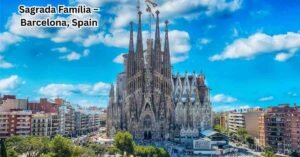Notre-Dame de Paris – Paris, France
Notre-Dame de Paris, also known as Notre-Dame Cathedral, is one of the most iconic landmarks not only in Paris but in the world. A masterpiece of French Gothic architecture, it has stood on the Île de la Cité in the heart of Paris for over 850 years, witnessing revolutions, coronations, wars, and restorations. Though the cathedral was tragically damaged in the 2019 fire, its soul and legacy endure, and it remains one of the most visited and admired historic religious sites in Europe.
Origins and Historical Importance
Construction of Notre-Dame began in 1163 under the reign of King Louis VII and was completed around 1345. It was built on the site of earlier churches and a Gallo-Roman temple. Over the centuries, the cathedral has played host to several historic events, including:
- The coronation of Napoleon Bonaparte in 1804
- The beatification of Joan of Arc
- The celebration of the liberation of Paris in 1944
- Countless royal weddings and national funerals
Notre-Dame is not just a cathedral—it is a national symbol of France’s cultural, religious, and political history.
Architectural Grandeur
Notre-Dame is considered one of the finest examples of French Gothic architecture, characterized by:
- Flying buttresses for external support
- Ribbed vaults that allow greater height and space inside
- Stunning rose windows made of stained glass
- Intricate façade sculptures, including saints, gargoyles, and biblical figures
The cathedral’s western façade features two majestic towers, rising to 69 meters, which once housed large bells—one of the most famous being Emmanuel, known for its rich tone.
The building’s massive interior could accommodate over 6,000 worshippers, and its central spire, rebuilt in the 19th century by Eugène Viollet-le-Duc, once rose to 96 meters before being destroyed in the 2019 fire.
The 2019 Fire and Restoration
On April 15, 2019, a fire broke out beneath the roof of Notre-Dame, quickly spreading and destroying the wooden framework, roof, and central spire. The images of the burning cathedral shocked the world and led to an outpouring of emotional and financial support.
In the aftermath, over €1 billion was pledged for its restoration. French President Emmanuel Macron promised that Notre-Dame would be rebuilt, and full restoration is currently underway, with hopes to reopen in late 2024, in time for the Paris Olympic Games.
Despite the fire, many of the cathedral’s treasures were saved, including the Crown of Thorns, Tunic of Saint Louis, and several relics and artworks. The main structure, façade, and towers remained intact, thanks to the efforts of firefighters and preservation teams.
Notre-Dame in Literature and Culture
Notre-Dame has inspired countless artists, poets, and writers. The most famous literary work featuring the cathedral is Victor Hugo’s “The Hunchback of Notre-Dame” (1831), which brought attention to the deteriorating state of the building in the 19th century and helped spark a major restoration campaign.
Hugo described Notre-Dame as a “gigantic symphony in stone,” and his novel helped solidify the church as a central symbol in French culture. The story of Quasimodo and Esmeralda has since been adapted into operas, films, and stage performances.
Visitor Experience and What to See
While the cathedral itself remains closed to the public for restoration, visitors can still enjoy its exterior beauty, walk around the Île de la Cité, and take guided historical tours of the area.
When fully open, highlights inside Notre-Dame include:
- The North and South Rose Windows — stunning 13th-century stained glass masterpieces
- The Great Organ — one of the largest and most famous in the world, with over 8,000 pipes
- The crypt — showcasing ancient ruins beneath the cathedral
- The treasury — housing religious artifacts and relics
- The Gargoyle Gallery — accessible from the towers for panoramic views of Paris
Until reopening, the restoration site itself has become an educational attraction, with informational panels, 3D visualizations, and exhibitions explaining the reconstruction efforts.
How to Reach Notre-Dame
Address: 6 Parvis Notre-Dame – Pl. Jean-Paul II, 75004 Paris, France
By Metro:
- Take Line 4 to Cité Station, just steps away from the cathedral
By RER:
- RER B or C to Saint-Michel Notre-Dame
By Bus:
- Bus lines 21, 38, 85 stop nearby
By Foot:
- Located on the Île de la Cité, it’s a short walk from the Latin Quarter or the Louvre
Best Time to Visit
Any time of year is great for visiting Notre-Dame’s exterior and surrounding areas. Spring and early summer (April–June) offer the best weather, while fall (September–October) provides a peaceful atmosphere with fewer crowds.
Special religious events like Christmas Midnight Mass and Easter services—once held inside the cathedral—are currently hosted at other nearby churches during the restoration.
Nearby Attractions
- Sainte-Chapelle – A Gothic chapel with dazzling stained glass
- Conciergerie – Former palace and revolutionary prison
- Latin Quarter – Quaint streets with bookstores and cafés
- Louvre Museum – One of the world’s largest and most visited museums
- Pont Neuf – The oldest standing bridge across the Seine
Tips for Visitors
- While you can’t enter the cathedral until restoration is complete, you can walk around, take guided historical walking tours, or visit temporary exhibitions.
- Check official websites for reopening dates and updated information.
- Visit during early morning or late evening for fewer crowds and beautiful light for photography.
- Use the free walking paths along the Seine for the best river and cathedral views.
Final Thoughts
Notre-Dame de Paris is more than just a church—it is a timeless icon of faith, artistry, resilience, and national pride. Even during its restoration phase, the cathedral continues to inspire awe with its towering façade, Gothic beauty, and deep spiritual and historical roots.
Whether you’re a pilgrim, history enthusiast, or traveler drawn by its legacy, Notre-Dame remains an unmissable stop in the heart of Paris. As restoration efforts continue, the cathedral stands as a symbol of hope—ready to rise again, just as it has through centuries of change.
Would you like this in HTML format or also translated into Hindi/Spanish manually for your /hl setup?



